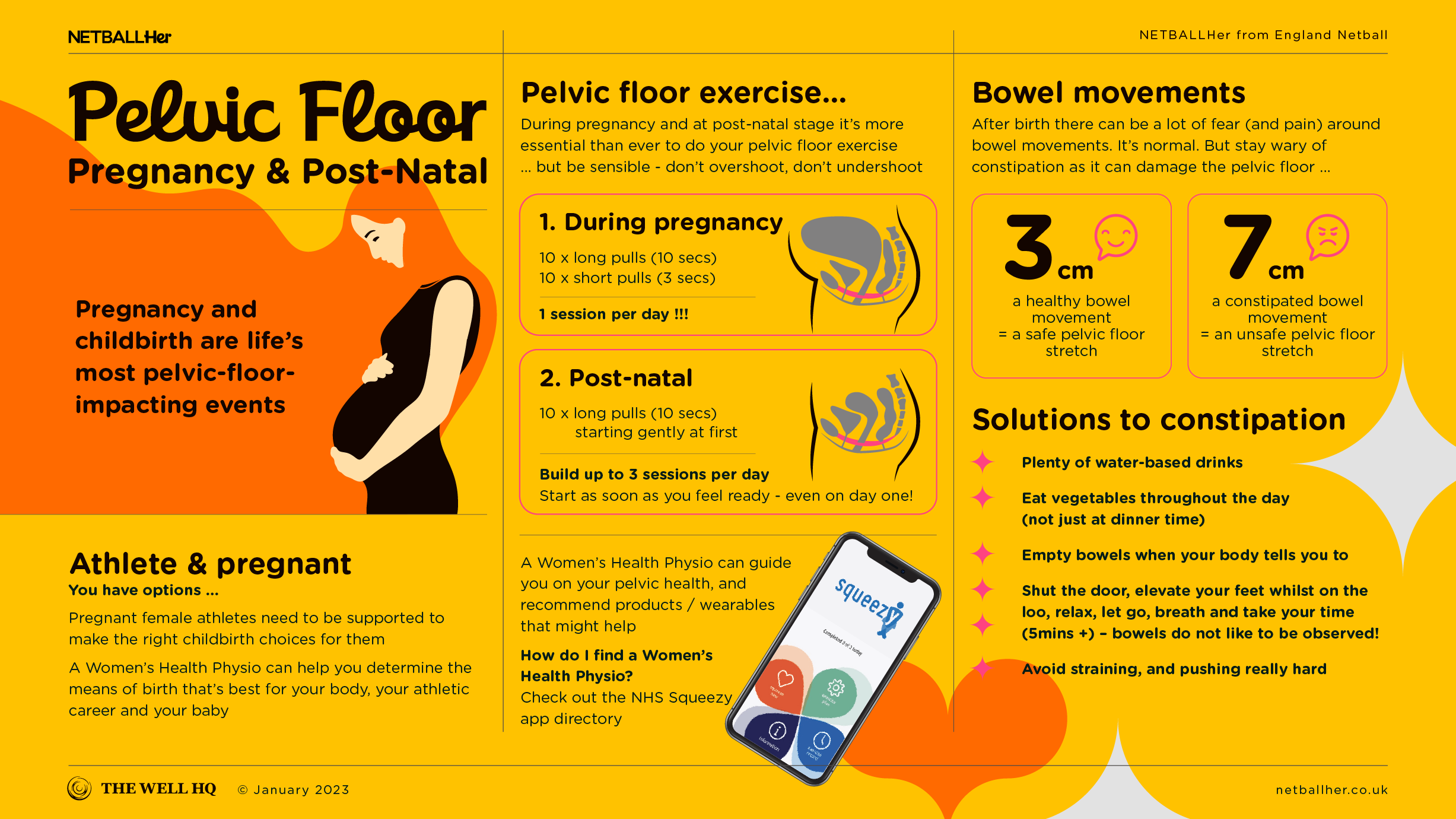Click play for an audio readthrough of this article
Pregnancy and childbirth are life’s most pelvic-floor-impacting events so let’s do the right things, talk to the right people and pass it on.
The pelvic floor supports the bladder, bowel and pelvic organs. The strain and stress of a developing baby and childbirth – especially a vaginal delivery – are likely to be the most pelvic-floor-impacting events in a woman’s life.
Pre and post-natal women are rarely strangers to issues stemming from that area of the body. Leaking, wind, pain …
What can we do about it? A lot.
The pregnant athlete
The first thing to say is that some female athletes have very tight pelvic floors due to the nature of their sport and fitness regimes. We commonly see this in cyclists, athletes, gymnasts and, yes, netball players too.
If this could be you – and you’re pregnant or thinking about it – it’s best to go and see a Women’s Health Physio (WHP) who, through an internal exam, can help you gauge where your pelvic floor’s at.
Armed with information, you can then make an informed choice over the type of birth you want. A very tight pelvic floor and you may want to consider a C-section.
Pelvic floor exercise during pregnancy
Ideally you’ll have started training your pelvic floor long before you get pregnant! But if you haven’t – don’t worry, you’re not alone and it’s never too late to start.
During pregnancy, pelvic floor exercise is more essential than ever but it’s important to be sensible. Don’t overshoot, don’t undershoot. Aim for one pelvic floor exercise session per day in which you do a set of 10 long pulls and a set of 10 short pulls.
Here’s a reminder of our recommended technique.
As you progress through pregnancy, your posture will change as your belly pulls you forward and the pelvis tilts. It will become harder and harder to do your pelvic floor exercises standing up but that’s OK – switch to doing them sitting or lying down.
The important thing is to keep doing them.
Overdoing it and underdoing it
Pregnant athletes and active women are perhaps preconditioned to want to overdo pelvic floor exercises. When they hear that a muscle needs tuning up, competitive mums-to-be latch onto that task like they’re trying for a new PB.
That’s ill advised.
Conversely, there’s a myth that says training the pelvic floor when pregnant risks tightening it to the extent it makes birth more difficult. This idea, though completely false, scares some pregnant women into avoiding pelvic floor exercise entirely.
That’s also ill-advised.
Pelvic floor exercise when pregnant is vital. But consistency and moderation are key.
The post-natal pelvic floor
You can start your pelvic floor exercises as soon as you feel ready, there’s no need to wait for your six-week check up. You can restart on day one if you’re up to it.
But once again, be sensible and take your time …
Because whether C-section or vaginal delivery, your body has been through major trauma. You’re not aiming for long pulls and major reps straight away. Initially, it’s more about reconnecting with your body and using our recommended technique to reengage with the pelvic floor muscles: where they are and how they feel.
So go at your own pace. As you recover, gradually build to 10 pulls three times a day.
Constipation and practical changes
Whether pregnant or post-natal, stay mindful of your bowel movements. After giving birth, there can be a lot of fear (and pain) around bowel movements. That’s very normal.
But it’s essential to note that constipation can be very damaging to a pelvic floor – especially one that’s recovering. Why? A healthy bowel movement stretches the pelvic floor by 3cm, a constipated bowel movement stretches the pelvic floor by 7cm. Too much of that can cause pain and problems.
So if you’re constipated try to resolve it as a matter of urgency. Look at your fluid intake, up your fibre – via real food and not supplements – and elevate your feet when on the loo (use a toddler step or box) so your knees are slightly above your hips. Knees up, lean forward, relax and breathe – this can be such a simple, easy fix for women suffering from constipation.
Look at your diet too. Various stimulants have the potential to cause and exacerbate pelvic floor issues. Cutting down on sugar, alcohol and caffeine (though if you’re pregnant you may be doing some of that anyway) can help to alleviate symptoms and provide a solid base for you to maximise the benefits of pelvic floor exercise.
More on Women’s Health Physios
Women’s Health Physios (WHP) are specialists specifically trained to diagnose and treat pelvic floor symptoms. They are available on the NHS but they’re hugely in-demand and you may have to go private if you want to see one in good time.
In France, all new mothers are provided as standard with la rééducation périnéale – that’s 10–20 sessions of support with a women’s health specialist. Unfortunately, this isn’t the case in the UK and it’s fair to say we’re a bit behind in the support we offer new mums.
Behind in support and also awareness: I took a workshop in 2021 and not one female in a room of 20 knew what a Women’s Health Physio was. This is problematic because WHPs are an essential port-of-call for pregnant women and new mums.
Women’s Health Physio consultation
It’s recommended all new mums go to see a Women’s Health Physio within two months of giving birth: six weeks after a vaginal delivery and eight weeks after a C-section.
A Woman’s Health Physio is the best person in the best position to tell you where your body’s at, what to do to help you recover, and when and how to get back into exercise.
The Squeezy App Directory will help you find a WHP but, again, do note that availability and waiting times might force you to go private.
Pelvic floor: exercise and pass it on
The pelvic floor. When we’re young, few of us are taught what it is, what it does and how to exercise it. For many, pregnancy and childbirth are the first time pelvic floor comes into focus.
That’s a shame. Because girls forming good pelvic health habits early will do their future selves a whole lot of favours.
The odds of developing pelvic floor problems might be one in three in the general population, rising to one in two in athletes. But the odds of developing issues go through the roof during pregnancy and post-childbirth. Impact can be severe and long-lasting unless we know the landscape and take action.
We also need to be responsible and pass on this info to our friends, peers, daughters, sons … so the right messages get through and we can help future mums avoid pelvic floor pains and problems, many of which can be eased with better practice – and the right action at the right time.
As a reminder, the content of the course belongs to The Well HQ. You have permission to access and use the content yourself or, if you are an organisation, for the number of users selected, but are not otherwise permitted to share such content with others, all in accordance with our Course Terms and Conditions.

